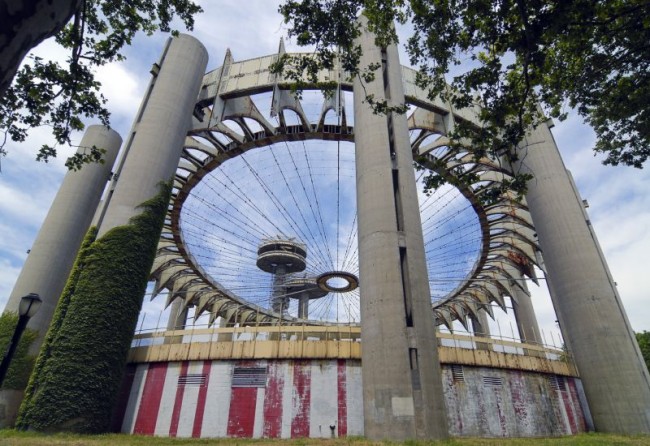
We are celebrating 15 years — and counting — of stories that are deeply researched and deeply felt, that build a historical record of what the city has been.
We are celebrating 15 years — and counting — of stories that are deeply researched and deeply felt, that build a historical record of what the city has been.

The New York State Pavilion in Flushing Meadows Corona Park, Queens | Photo via tomspixels
Flushing Meadows Corona Park has its fair share of eye-catching structures, ranging from the looming Terrace on the Park to NASA rockets at the New York Hall of Science to the famed Unisphere. Arguably the most curious, however, is the New York State Pavilion. Like the Terrace, Hall of Science, and Unisphere, the Pavilion is a remnant of the 1964 World’s Fair. Its concrete observation towers provided views over the fairgrounds and out to the rest of the city, and the Tent of Tomorrow — the adjoining elliptical arena — shaded a massive map of the Empire State with a cable-suspended roof of multi-colored glass.
Unlike its companions, the Pavilion, designed by architect Phillip Johnson, has not benefited from much upkeep or any use since it was shuttered in 1976. But on the 50th anniversary of the opening day of the 1964 World’s Fair, the Tent of Tomorrow will be open to the public for a rare and momentary viewing. Go check it out if you can sneak out of work between 11am and 2pm next Tuesday, April 22nd. No RSVP required.
While public access to the historic structure (however brief it may be) is worth celebrating, the future of the Pavilion, and that access, is very uncertain. Last year, the City’s Parks Department released cost estimates for three possible paths forward: $14 million for demolition, $43 million for stabilization with no public access, or $52 million for restoration into an active attraction. Setting aside the debate over whether the Pavilion is a treasure or blight, these numbers don’t bode well for the chronically underfunded park. Private contributions of $25 million last year from the developers of a mall on former parkland to the north and the US Tennis Association, on the occasion of the expansion of its complex in the park, were considered a relative windfall. But the funds are reserved for capital projects, maintenance, and programming spread over the next 25 years. Most funding for any future movement on the Pavilion would have to come from outside of the Parks Department.
The Pavilion has, however, found a new advocate in Queens Borough President Melinda Katz, who plans to request $14 million from the City Council to get a restoration process underway. A community group, People for the Pavilion, is pursuing preservation and restoration as well, and they join a longstanding crew of community volunteers who have kept the Pavilion painted in its characteristic red and white strips since 2009. The 50th anniversary of the ’64 Fair, and an accompanying series of events that the opening of the Pavilion launches, will bring renewed attention to its state, and possibly renewed interest in a future life for its towers and tent.
For now it stands as another monument to the challenges of preservation and the cost of deferred maintenance, all in a park that has come to exemplify inequitable park funding in New York. For those significances alone, it deserves a visit.
The views expressed here are those of the authors only and do not reflect the position of The Architectural League of New York.